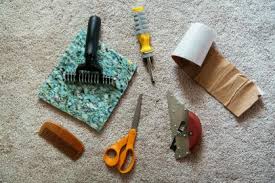Repairing Damaged Carpets: A Step-by-Step Guide

Carpets, while beautiful and comfortable, can suffer damage over time due to heavy foot traffic, spills, pet accidents, or unforeseen accidents. Fortunately, many common carpet issues can be repaired, extending the life and appearance of your carpet. In this article, we’ll explore the step-by-step process of repairing damaged carpets, from minor snags to more significant issues.
- Assess the Damage
Before you start any repair work, it’s essential to assess the extent of the damage to your carpet. Identify the type of damage, whether it’s a small snag, a stain, a burn, or a larger area that needs patching. Understanding the nature of the damage will help you choose the appropriate repair method.
- Gather Necessary Tools
For most carpet repairs, you’ll need a few basic tools:
Carpet adhesive
Carpet remnants (for patching)
Carpet tape
Scissors
Seam iron (for seam repairs)
Carpet cleaner
Stain remover
A clean, dry cloth
- Repairing Small Snags and Pulls
If you have a small snag or pull in your carpet, you can often fix it without too much trouble. Here’s how:
Use scissors to carefully trim any loose fibers around the snag.
Apply a small amount of carpet adhesive under the remaining snag and press it down gently with a clean cloth. Be sure not to use too much adhesive to avoid creating a visible patch.
- Removing Stains
Stains are a common carpet issue, but they can often be treated effectively. Here’s a basic stain removal process:
Blot the stain gently with a clean, dry cloth to absorb as much of the liquid as possible.
Apply a carpet cleaner specifically designed for the type of stain you’re dealing with (e.g., wine, coffee, pet urine). Follow the instructions on the cleaner and blot the stain again.
Rinse the area with clean water and blot until the stain is gone.
Allow the carpet to dry thoroughly.
- Patching Small Holes or Burns
For small holes or burns, patching can be a viable option. Here’s how:
Cut a small piece of matching carpet from a hidden area, like inside a closet or under furniture.
Carefully cut out the damaged portion of the carpet in a neat square or rectangle.
Apply carpet adhesive around the edges of the hole or burn.
Press the patch into place, ensuring the fibers align with the surrounding carpet.
Place a heavy object on top of the patch and let it sit for a few hours to ensure a strong bond.
- Repairing Loose Carpet Edges
If the edges of your carpet have come loose, you can use carpet tape to secure them back in place. Here’s how:
Apply carpet tape along the loose edge of the carpet.
Press the edge firmly onto the tape, ensuring it aligns correctly with the rest of the carpet.
- Fixing Seams
If the seam between two sections of carpet has come apart, you can rejoin them using a seam iron. Here’s how:
Gently lift the edges of the carpet along the seam.
Apply carpet adhesive to both sides of the seam, making sure not to use too much.
Use a seam iron to heat the adhesive, then press the edges of the carpet back together.
Place a heavy object along the seam until the adhesive dries.
- Hiring a Professional
For extensive damage or if you’re unsure about your repair skills, it’s always best to consult a professional carpet repair service. They have the experience and tools to handle more complex repairs and can ensure a seamless result.
Remember, regular maintenance and prompt attention to small issues can help prevent more extensive damage to your carpet. By following these steps and taking care of your carpet, you can enjoy its comfort and beauty for years to come.



